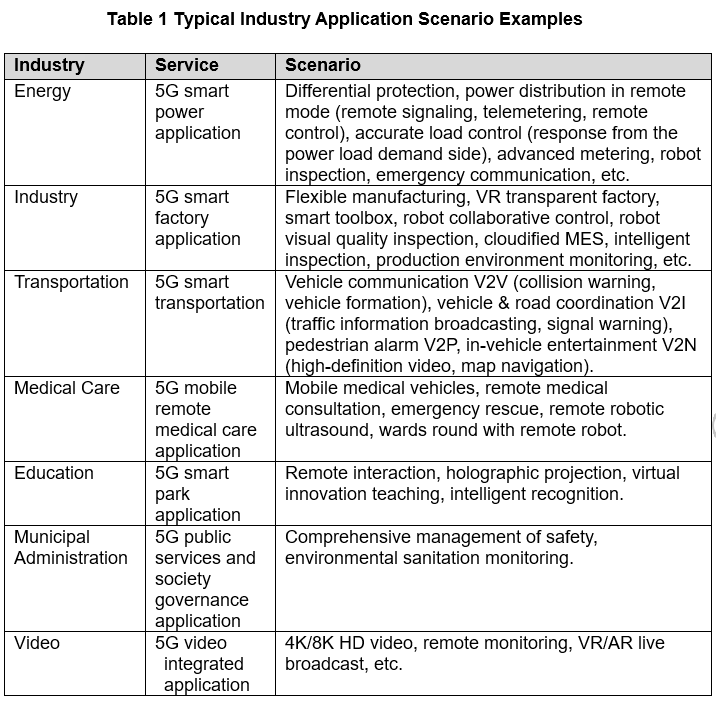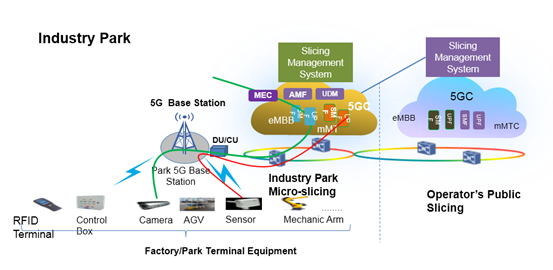5G Network Slicing Boosts the Digital Transformation of Vertical Industry
Scenarios and demands of digital transformation of industry applications
Digital transformation is to apply the digital technology to enterprise production, business operation or enterprise management. In the 5G era, operators are setting examples of how to make applications of various typical business scenarios in the fields such as medical care, transportation, industry, energy, municipal administration, education, and video, and promoting the applications of 5G technology in the digital transformation of vertical industries.

In the transformation of many vertical industries, operators will focus on “smart grid, smart manufacturing, and Internet of Vehicles”, which are also the important strategic direction for the development of national “cyber power” and “industrial internet”.
In smart grid, through the digital transformation, the 5G network slicing technology covers the grid communication services with respect to five major links: power generation, power transmission, power substation, power distribution, and power utilization. 5G solves the problems such as high cost of fiber laying and limited development of new services.
In intelligent manufacturing such as aircraft manufacturing, Internet of Everything and the fully-digitalized production flow are achieved through the digital transformation. Through digital conversion, the production reliability is promoted, the production/assembly efficiency is improved, and the (production and operation) costs are reduced, to create a first-class industrial intelligent manufacturing system.
In Internet of Vehicles, low-latency services of V2V, V2I, and V2P are provided through digital transformation to achieve automatic driving, vehicle formation, and vehicle collision avoidance; V2N high-bandwidth services are provided to realize high-definition map downloading and in-vehicle entertainment.
Digital transformation solution of industrial applications based on 5G slicing
In the digital transformation of industrial applications, requirements of various services for latency, bandwidth, and security vary greatly, and it is difficult for a single network to meet the requirements. ZTE 5G network slicing can provide flexible networking, slice online migration, slice capability exposing, 5G LAN/TSN and other key technologies and solutions. Combined with MEC, they can support and meet various needs in the digital transformation of industrial applications.
Flexible 5G slice deployment scenarios to meet the networking needs of digital transformation in different industries: According to different coverage and security isolation requirements of the industry applications, ZTE provides slice deployment solutions such as closed scenarios, semi-closed scenarios and open scenarios. Closed scenarios include industrial parks and production workshops; open scenarios include Internet of Vehicles and smart grid; the example of semi-closed scenarios is that the same terminal may simultaneously access the internal or external slices of the campus. ZTE provides flexible networking through 5G slices for different scenario characteristics.
For example, in a closed scenario, the entire 5GC is deployed in an industrial park, including AMF, SMF, UPF, and UDM. At the same time, different micro-slices can be constructed according to business needs, such as eMBB (video surveillance), mMTC (sensor), and Flexible Manufacturing (URLLC). For a slice management system, you can deploy it in an industrial park. The enterprise provides O&M for the slice itself or deploys it in the carrier’s data center. The campus slice is serviced by the carrier.

Figure 1 Closed Scenarios
5G LAN/TSN support for point-to-point and point-to-multipoint communication requirements in industrial applications: ZTE provides 5G LAN-based slices (such as URLLC slices for grid differential protection), to realize UE-to-UE communication through UPF for data interaction, service unloading, and transmission latency reduction. It provides the 5G LAN terminal group management technology to adapt to the change of the industry control terminal topology. This technology can not only support the direct communication of business terminals in the power grid, but also support the cooperation between robots in the manufacturing industry, as well as the rapid interconnection and wirelessization of devices in the office area such as printers and notebook computers.

Figure 2 E2E Direct Communication
Online migration of slices to support differentiated operations in the vertical industry: ZTE offers slice online migration solutions that enable industrial applications to allow users to dynamically join or exit from their own slices, or migrate from one slice to another. Through the slice migration technology, the industry application can well carry out differentiated operations such as online games and high-definition theaters, or VIP rights operations. For the same service, it can run on slices of different SLA levels, such as normal slices and high-quality slices (such as ultra-low latency slices or high bandwidth slices). For the access of ordinary users to services through normal slices by default, high-end industry users can purchase acceleration packages online through the online mall or industrial application portal, thereby dynamically migrating to high-quality slices to provide a better business experience.
Exposing the capability of slicing to enable the visual and controllable function of industrial application slices: The slice capability exposing solution supports visualization, controllability and service customization of slices, thereby supporting user terminal management in the slice, QoS control and slice monitoring:
1) Terminal management: The capability is exposed to get the status and location of the terminal (such as robot and sensor) in the slice to realize the development of new services and new functions, such as formation management of vehicles and availability detection of power grid terminals.
2) QoS control: The capability of the PCF is exposed to modify the QoS package of the user in the slice to enhance the user experience. For example, for the VIP user of the Game of Kings, the acceleration package can be ordered; for the differential protection of the power grid, the delay strategy is modified.
3) Slice monitoring: Through the capability exposing, the status of the slice is obtained, and it is detected whether the latency and bandwidth of the actually-running slice meets the SLA requirements submitted when the slice is subscribed.
5G slice + MEC to support the development of new applications in the industry: In the intelligent manufacturing industry, there are a large number of massive storage and high-performance computing services such as image recognition, video analysis, and VR rendering. It is characterized by a large amount of data and does not leave the park. MEC provides edge computing, and is close to the user side. Meanwhile, it has software acceleration (DPDK) and hardware acceleration (such as GPU and FPGA) technologies. ZTE offers a solution that combines MEC's high-performance computing with slicing low-latency to enable the development and digital transformation of many industry applications, such as:
1) VR transparent factory: Low latency and high bandwidth communication of VR is achieved through 5G eMBB slice + MEC. Through local traffic forwarding of slices, MEC GPU acceleration, and image rendering, the assembly process is fully digitized, creating a digital twin and VR immersive user experience.
2) Unmanned aerial vehicle (UAV) quality inspection: For example, the drone in the aircraft manufacturing industry needs to detect the painting on the surface of the aircraft, especially the top of the aircraft, and the video is transmitted back in real time. The 5G eMBB slice + MEC solves the problems, such as full range of video/photo shooting, returning, and analysis made by the UAV.
Outlook of how slicing boosts the digital transformation of the industry
5G slicing is an important digital technology in 5G, which integrates advanced technologies such as cloudification/virtualization, security isolation, automation, artificial intelligence, and hardware/software acceleration. With the advancement of 5G, 5G slicing will be gradually applied to all walks of life, promoting the development of smart manufacturing, smart grid, and Internet of Vehicles, and the construction of smart city, smart park, smart campus, and smart health care, thus helping the digital transformation of vertical industry applications and comprehensively promoting the development of the information society.
